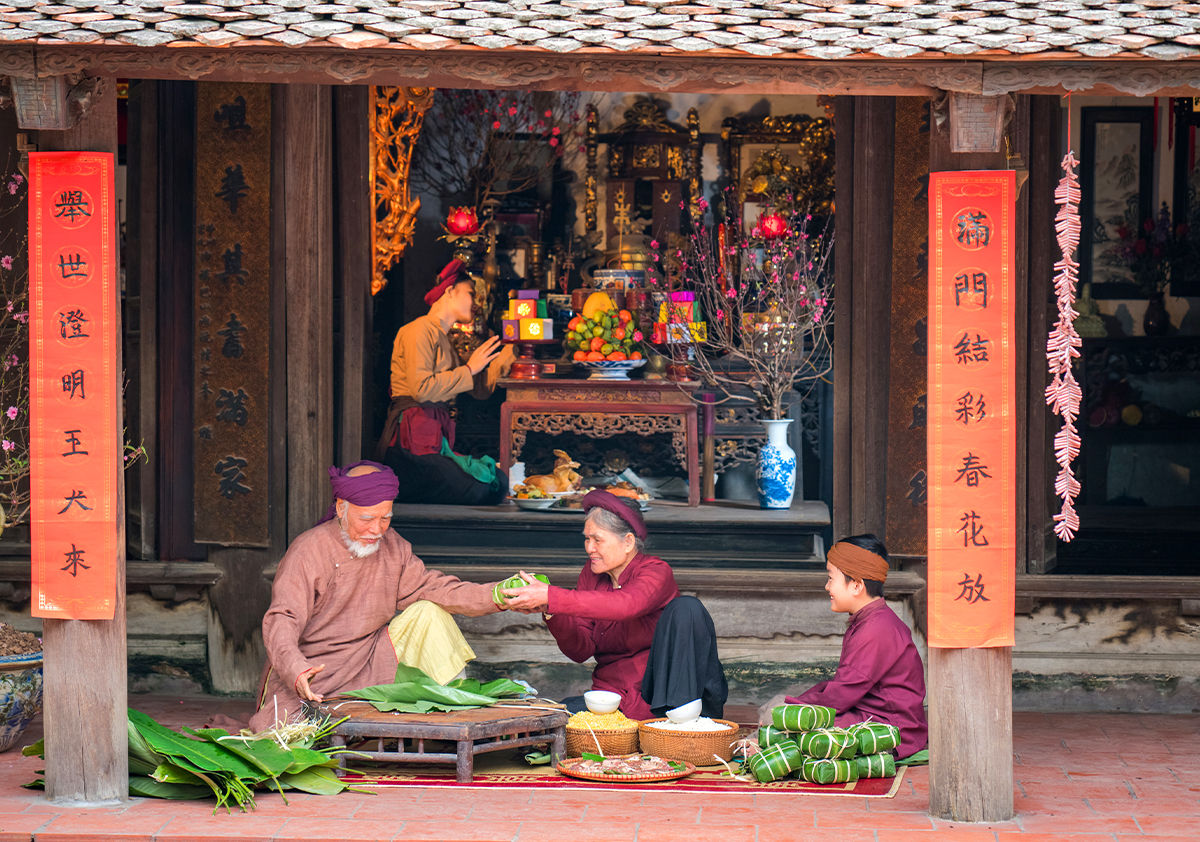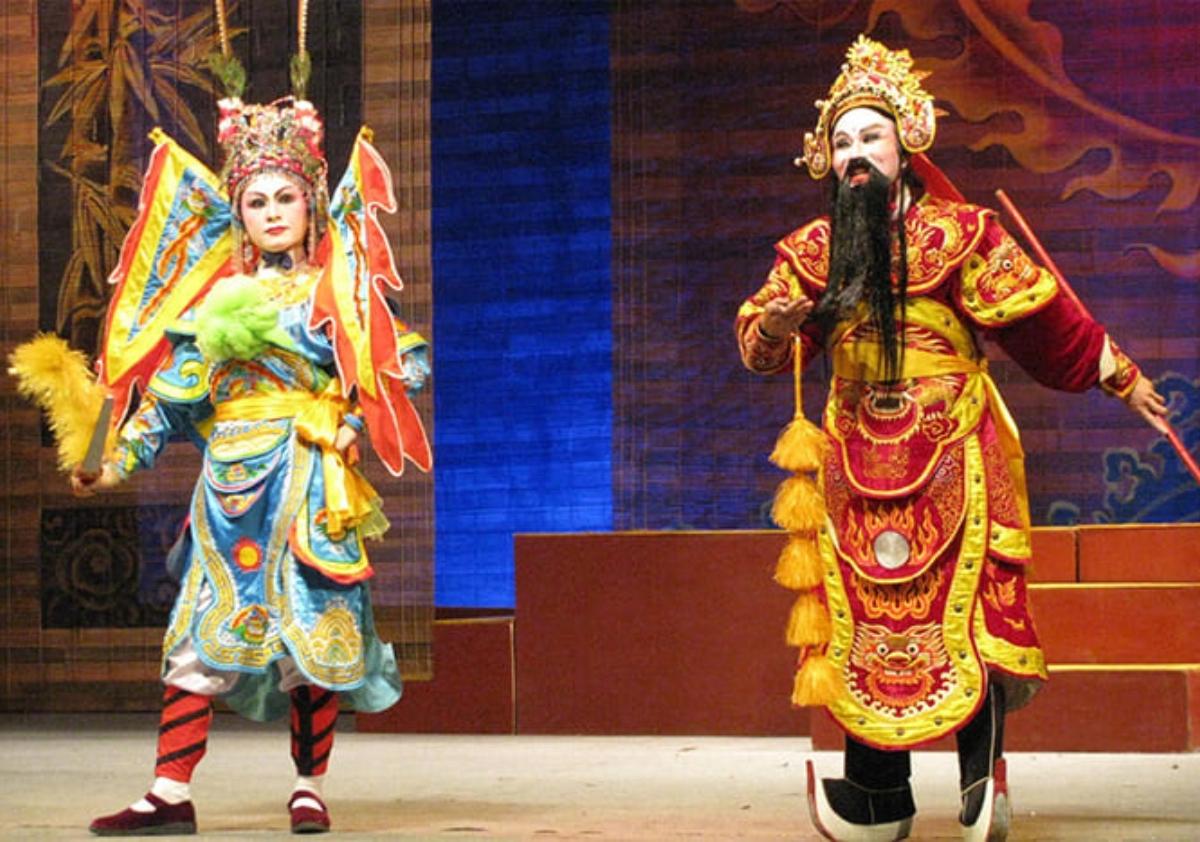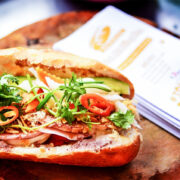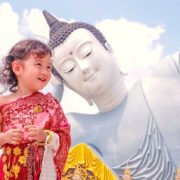
Vietnamese Culture: Family, Attire, Traditions, Beliefs, Festivals, etc
Throughout its history, Vietnamese culture has endured numerous ups and downs while preserving its core values. These include a deep love for one’s homeland, national pride, a spirit of solidarity, industriousness, creativity, and compassion. Such values are vividly reflected in various cultural domains, including literature, art, architecture, and cuisine.
Family Life
Historically, Vietnamese society has been characterized by multi-generational households gathered under one roof. The belief that “the family is the foundation of society” is deeply ingrained in the Vietnamese consciousness, fostering cherished traditional values.
However, influenced by Confucianism and feudal ideologies, gender roles within the family have often been unequal. Women have frequently found themselves constrained by the tenets of “three obedience and four virtues,” while decision-making power has resided predominantly with men.
A significant transformation began with the reunification of the country. Legislation regarding marriage and family laid the groundwork for a gender-equal society. Active media campaigns have contributed to raising community awareness, leading to shifts in mindsets and behaviors for many individuals.

Today, Vietnamese families have evolved, typically consisting of two or three generations, with most couples having two children. Relationships among family members have also become more open and democratic. Nevertheless, alongside these positive changes, challenges such as economic pressures, loneliness among the elderly, and generational conflicts remain to be addressed.
Despite these transformations, the value of “respect for the elderly and love for children” continues to be upheld and cherished. This cultural hallmark is essential to preserve and promote, contributing to the development of a united and warm society.
Attire
Attire is not merely clothing; it is an indispensable element of each nation’s cultural identity. In Vietnam, every ethnic group boasts its own traditional garments, each imbued with distinct characteristics.
Natural materials such as cotton, silk, and hemp are employed to create outfits that are both comfortable and visually appealing. Vivid, intricate patterns and motifs serve as hallmarks, showcasing the skill and artistry of artisans.
Traditional Vietnamese attire historically features simple yet elegant designs. Men typically wore short jackets with long trousers and conical hats, while women donned fitted blouses and long skirts, topped with traditional conical hats. These garments not only fulfilled aesthetic desires but also catered to the climatic conditions and labor needs of the people.

With the influence of cultural exchange, traditional Vietnamese clothing has undergone significant evolution. The áo dài, a product of the convergence of Eastern and Western cultures, has emerged as a symbol of Vietnamese womanhood. Modern adaptations of the áo dài, with innovations in style and fabric, accentuate the gentle and graceful beauty of Vietnamese women.
Today, despite the myriad changes brought by modern life, traditional attire retains an important place in the cultural fabric of Vietnam. Many young people are embracing and exploring traditional clothing, viewing it as a vital aspect of cultural heritage that deserves preservation and promotion.
Major Festivals
Festivals are an integral part of the spiritual life of the Vietnamese people. For centuries, traditional festivals have served as a bridge connecting communities, preserving and disseminating beautiful cultural values. Each festival is like a vibrant tapestry, reflecting the rich spiritual life of the populace.
The timing of festivals is often linked to agricultural cycles and significant historical events. Spring and autumn are the most vibrant festival seasons, when nature is teeming with vitality and people feel more relaxed and enthusiastic. Major celebrations such as Tết Nguyên Đán, the Hùng Kings’ Festival, and the Lim Festival provide not only opportunities for recreation but also occasions to express gratitude to ancestors and deities, as well as to wish for peace and happiness in the coming year.
Tết Nguyên Đán, the largest and most significant festival for the Vietnamese, is a time for family reunions, with children returning to their ancestral homes. Traditional customs such as making bánh chưng, giving lucky money, and offering New Year greetings have become distinctive cultural markers of the nation.
Vu Lan Festival (The Full Moon of July)
The Vu Lan Festival carries profound significance regarding filial piety, offering descendants a chance to express gratitude for the nurturing care of parents and grandparents. According to folk beliefs, on this day, the spirits of the deceased return to reunite with their families.

Families typically hold solemn ceremonies to honor their ancestors, with offerings of traditional dishes and incense smoke symbolizing the reverence of their descendants. Additionally, the burning of joss paper is an important ritual meant to provide essential items for those in the afterlife.
Vu Lan is not merely a religious observance; it also serves as an occasion for family gatherings, allowing members to share stories about their departed loved ones. Through this, familial bonds are strengthened, and the moral principle of remembering one’s roots is passed down from generation to generation.
Mid-Autumn Festival (Tết Trung Thu)
The Mid-Autumn Festival, one of Vietnam’s most beautiful traditional celebrations, is a time for everyone, especially children, to revel in the brilliance of a full moon. On the night of the 15th day of the eighth lunar month, streets and alleys come alive with colorful lanterns and the joyful chatter of children.

Kids eagerly anticipate meaningful gifts like star-shaped lanterns, masks, and mooncakes. They parade with their lanterns and sing songs about the moon and the festival. For adults, this occasion is a chance for family reunions, where they savor delicious mooncakes while admiring the bright, round moon.
The Mid-Autumn Festival is not only a celebration rich in traditional culture but also a moment for people to experience love, unity, and warmth within their families.
Hùng Kings’ Festival
On the 10th day of the third lunar month, the entire nation of Vietnam turns its attention to the land of the Hùng Kings, honoring the founders of the nation. The Hùng Kings’ Festival is one of the most significant and sacred holidays for the Vietnamese, reflecting deep gratitude toward the Hùng Kings for their role in establishing and protecting the nation.

The festival is held solemnly at the Hùng Temple in Phú Thọ, regarded as the cradle of the Vietnamese people. Thousands gather from across the country to offer incense, pray, and remember the Hùng Kings. The atmosphere is both solemn and warm, filled with colorful flags, incense, and the sounds of ceremonial drums.
In addition to the main celebration at the Hùng Temple, the Hùng Kings’ Festival is also observed nationwide and in many countries with Vietnamese communities. This demonstrates the Vietnamese people’s enduring awareness of their roots and the importance of their national history.
Literature
Vietnamese literature, a cultural river flowing through thousands of years of history, has chronicled the triumphs and tribulations of the nation. As a multi-ethnic country, Vietnam possesses an incredibly rich and diverse literary heritage, with each ethnic group contributing to a unique cultural tapestry.
Traditional Literature
Traditional Vietnamese literature, imbued with profound cultural values, has accompanied our nation through countless generations. Its roots can be traced back to folk literature, a vast treasure trove formed by the intellect and soul of the people. Passed down orally from generation to generation, folk literature captures stories, folk songs, proverbs, and legends about deities and national heroes, vividly reflecting the lives, emotions, and sentiments of the Vietnamese people.

In addition to folk literature, literary works in Classical Chinese and Nôm script have played significant roles in the evolution of Vietnamese literature. Chinese characters were introduced to Vietnam during the period of Chinese domination and became a medium for creating valuable literary works. Vietnamese Confucian scholars used Chinese characters to translate texts, compose poetry, and write essays, contributing to the establishment of a written literary tradition in the country. Nôm, a unique creation of the Vietnamese people, provided literature with a distinct identity, expressing national spirit and cultural essence.
Classical works such as “Bình Ngô đại cáo” by Nguyễn Trãi and “Truyện Kiều” by Nguyễn Du are not only literary masterpieces but also invaluable cultural treasures of the nation. We must cherish and preserve these precious cultural values so that future generations could explore and inherit them.
Nôm Literature
Nôm script, a unique creation of the Vietnamese, has significantly contributed to a vast and diverse literary heritage. Emerging in the 8th century, Nôm gradually developed and reached its peak in the 18th century. Works written in Nôm are not only exquisite literary pieces but also authentic reflections of the lives, emotions, and sentiments of the Vietnamese people of old.
Famous Nôm works such as “Bình Ngô đại cáo” by Nguyễn Trãi, “Truyện Kiều” by Nguyễn Du, and poetry by Hồ Xuân Hương have become national cultural treasures. Through these works, readers appreciate the talent and creativity of poets and writers while gaining deeper insights into the nation’s history and culture.

Nôm literature possesses both literary and profound historical and social significance. Many Nôm texts reflect historical upheavals, the struggles of the nation, and the aspirations for freedom and happiness of the people.
However, for various reasons, Nôm literature is gradually being forgotten today. Preserving and promoting the values of Nôm literature is an important task for every Vietnamese citizen.
Contemporary Literature
The advent of Quốc ngữ (the Romanized Vietnamese script) marks a pivotal turning point in the history of Vietnamese literature, ushering in a new era characterized by rich and diverse creative works in both content and form. Modern literature serves not only as a platform for authors to showcase their talents but also as a forum for expressing thoughts, emotions, and concerns about life and society.
Prominent writers such as Hồ Biểu Chánh, Hoàng Ngọc Phách, Nguyễn Trọng Thuật, Trương Vĩnh Kỳ, Tản Đà, Thế Lữ, Ngô Tất Tố, Nguyễn Công Hoan, Xuân Diệu, Huy Cận, Lưu Trọng Lư, and Nam Cao have played crucial roles in laying the foundation for modern literature. They have introduced new perspectives and insights into life and society. Their works possess not only artistic value but also deep social and historical significance.
Vietnamese modern literature continues to evolve and develop. Young writers inherit and build upon the traditions of previous generations while creating new styles and voices. They provide multifaceted views of life, society, and humanity, enriching the treasure trove of Vietnamese literature.
Revolutionary Literature (Post-1945)
Since the August Revolution in 1945, Vietnamese literature has undergone significant transformations, becoming a powerful voice of the era that vividly reflects historical upheavals and national aspirations. During the resistance against French colonialism and American imperialism, literature emerged as a sharp weapon, inspiring patriotism and the struggle for independence and freedom.
Following the reunification of the country, Vietnamese literature continued to thrive, showcasing a diversity of genres and rich content. Writers and poets have persistently created and explored new issues of life, ranging from tales of love and family to broader social themes. Vietnamese literature has played an essential role in nation-building and in nurturing a spirit of patriotism and humanity among the younger generations.
Vietnamese literature has transcended national borders and gained recognition from the international community. Many works have been translated into various languages, helping to promote the image of Vietnam and its people to friends around the world.
Performing Arts
Vietnamese performing arts present a vibrant tapestry of diverse forms, ranging from graceful dances and sweet folk melodies to traditional plays such as chèo and tuồng. Each region possesses its unique characteristics, contributing to a rich and distinctive cultural landscape.
Chèo, a form of folk theater, known for its humorous and relatable performances, has become an integral part of the spiritual life of the Vietnamese people. In contrast, tuồng, with its elaborate costumes and poignant dialogues, offers a more solemn and majestic atmosphere.
Water puppetry, a unique Vietnamese art form, has captivated audiences both domestically and internationally. With its nimble puppets gliding across the water, water puppetry is not merely entertainment but also a refined work of art.
Quan họ, the sweet folk melodies from Bắc Ninh, have been recognized by UNESCO as an intangible cultural heritage of humanity. The charming, heartfelt call-and-response singing has become a symbol of romantic love and the soulful beauty of the Vietnamese spirit.
In addition, there are many other forms of performing arts, such as ca trù, hát then, and hát lý, each showcasing its own beauty and enriching the cultural treasure of Vietnam.
Court Music and Dance
Court music and dance are integral components of Vietnamese culture, particularly during the feudal dynasties. Since the reign of Lê Thánh Tông, this art form flourished with a rich variety of genres, including Trung Cung Chí Nhạc, Yên Nhạc, Nhã Nhạc, Đại Nhạc, Vân Vũ, and Võ Vũ. Each genre possesses its unique beauty, serving various purposes from ceremonial rituals to entertainment.
During the Nguyễn dynasty, court music and dance reached their pinnacle with majestic and elaborate performances, such as the Bát Diệu dance. These dances were not merely artistic displays but also carried well-wishes directed toward the king and royal family. Dances like Múa Quạt, Tam Tinh Chúc Thọ, and Bát Tiên Hiền became symbols of wealth, prosperity, and longevity.

The Huế court music, known for its sophistication and perfection, has been recognized by UNESCO as a Masterpiece of the Intangible Cultural Heritage of Humanity. This recognition underscores the immense value of this art form, both for Vietnam and the international community.
Today, court music and dance are still preserved and celebrated. The melodies and movements from this era continue to resonate, reminding us of a golden age in our nation’s history.
Water Puppetry
Water puppetry, a distinctive art form of Vietnam, boasts a history spanning thousands of years. The sight of graceful wooden puppets gliding across the water, performing intricate and fluid movements, has become a cultural icon of the nation.
Each puppet is a unique work of art, embodying its own story and character. From mischievous clowns to whimsical animals and sacred deities, all are vividly and humorously brought to life. Controlling these puppets requires exceptional skill and dexterity, as puppeteers operate beneath the water’s surface, concealed behind a screen.

Music plays a crucial role in water puppetry, with the rhythmic sounds of drums and gongs blending with the laughter and cheers of the audience, creating a lively and festive atmosphere. Water puppetry is not just an entertainment medium; it is a comprehensive art form that combines sculpture, performance, music, and theater.
Today, water puppetry remains beloved and is actively preserved. Performances attract both tourists and locals, providing opportunities to showcase the beauty of traditional Vietnamese culture to the international community.
Chèo
Chèo, a unique form of folk theater in Vietnam, has accompanied the people through generations. Rooted in folk melodies and simple dances, it embodies the essence of rural life. With its straightforward lyrics and graceful movements, chèo has become an integral part of the spiritual life of Vietnamese people, especially in the Red River Delta.
What makes chèo particularly engaging is its dual nature as both an educational and entertaining medium. It imparts lessons on morality and humanity while also bringing joy and laughter. Humorous situations and witty dialogues contribute to its distinctive charm.

Chèo performances often draw from everyday life, reflecting the aspirations and dreams of the people. Through stories of love, family, and society, chèo offers profound and nuanced insights into life.
Beyond being a theatrical form, chèo is a valuable cultural heritage of the nation. Classic plays such as “Quan Âm Thị Kính” and “Lưu Bình Dương Lễ” have become beloved works, cherished by generations of audiences.
Tuồng (also known as Hát Bội)
Tuồng and cải lương are two precious gems in the treasure trove of Vietnamese theatrical art, each possessing a unique beauty yet sharing surprising commonalities.
Tuồng, with its long history and roots in folk theater, represents classical and dignified artistry. Each tuồng performance is a historical tableau, telling tales of heroes and grand battles through solemn dances, serious dialogues, and elegant court music.

In contrast, cải lương, which emerged later, has a more folk-oriented essence. It inherits much from tuồng while incorporating influences from various art forms, resulting in a distinctive style. Cải lương connects more closely with the lives of ordinary people, depicting stories of love, family tragedies, and social issues through sweet folk melodies and flowing movements.
Both tuồng and cải lương are comprehensive art forms, blending singing, dancing, music, and acting. However, tuồng leans toward formalism and ritual, while cải lương emphasizes realism and emotional depth.
Despite their differences, tuồng and cải lương both play vital roles in preserving and promoting the traditional cultural values of the nation. They are sources of pride for the Vietnamese people, cherished not only domestically but also internationally.
Architecture
Folk Architecture
Vietnamese folk architecture is not merely a form of shelter; it is a unique work of art that profoundly reflects the spiritual and cultural life of the Vietnamese people. From the simple stilt houses to the ancient temples, each architectural structure embodies its own distinct beauty and narrative.
The primary building materials used in folk architecture are those provided by nature: wood, bamboo, rushes, leaves, and stone. The humble, rustic thatched houses served as the residence for most of the Vietnamese populace in the past. In contrast, temples and communal houses are constructed from wood, adorned with intricate carvings that showcase the craftsmanship of skilled artisans.

Vietnamese folk architecture is diverse not only in materials but also in forms. From the simple stilt houses in mountainous regions to the three-aisled wooden houses in the lowlands, each area possesses its own unique characteristics. Religious structures such as pagodas, shrines, and temples also bear the distinct marks of their respective regions.
Vietnamese folk architecture represents not only a tangible cultural heritage but also a treasure trove of applied architectural knowledge. Ancient architects skillfully utilized natural conditions and climate to create harmonious and comfortable living spaces.
Today, the values of Vietnamese folk architecture are preserved and restored, remaining relevant and inspiring for contemporary architects. The study and enhancement of folk architectural values contribute not only to the preservation of cultural heritage but also serve as an endless source of inspiration for modern designers.
Foreign-Inspired Architecture
Vietnamese architecture is not merely a place of residence; it is a vibrant historical narrative that chronicles the influences of cultural exchange and the nation’s upheavals. From traditional stilt houses to modern skyscrapers, Vietnamese architecture has undergone a continuous transformation.
Starting in the 19th century, under the influence of Western powers, Vietnamese architecture began to exhibit notable changes. The harmonious fusion of traditional Vietnamese architecture and European styles resulted in unique structures that reflect a period of cultural intersection. Hanoi and Ho Chi Minh City became modern urban centers adorned with monumental and splendid architectural works.
After 1945, Vietnamese architecture continued to be shaped by various architectural styles, particularly Soviet architecture in the North and American architecture in the South, creating distinctive characteristics for each region.

During the period of renewal, Vietnamese architecture entered a phase of robust development. International integration has introduced fresh perspectives into Vietnamese architecture, marked by the emergence of numerous high-rise, modern structures that meet the demands of socio-economic growth. However, alongside these modern edifices, it remains essential to preserve and promote the values of traditional architecture.
Vietnamese architecture is a precious cultural heritage that reflects the creativity and talent of the Vietnamese people. Studying and preserving this architecture not only enhances our understanding of the past but also contributes to building a sustainable future.
Painting and Sculpture
Folk Painting
Vietnamese folk painting, an invaluable cultural heritage, has long been intertwined with the spiritual life of the Vietnamese people. These works of art are not merely aesthetic products; they embody stories, dreams, and aspirations of the populace.
Featuring familiar themes such as rural life, beliefs, and festivals, folk paintings authentically reflect the experiences of ancient Vietnamese society. Through their rustic and simple brushstrokes, imbued with a distinct folk essence, viewers are transported back to a bygone era, allowing them to appreciate the rich traditional values of the nation.
One of the defining characteristics of Vietnamese folk painting is the technique of woodblock printing. With skillful hands, artisans create unique artistic works that bear the distinct marks of their respective craft villages. Each painting is a finely crafted piece, from the design phase to the final touches.

Đông Hồ painting stands out as one of the most representative forms of folk art in Vietnam. With its vibrant colors and familiar imagery, Đông Hồ paintings have become a cultural symbol of the country, gaining admiration not only domestically but also on the international stage.
However, in the era of industrialization and modernization, folk painting faces numerous challenges. To preserve and promote this traditional art form, a comprehensive approach is necessary ranging from raising community awareness to supporting the villages that produce these artworks.
Modern Vietnamese Painting
The establishment of the Indochina College of Fine Arts in the 1920s marked a significant turning point in the history of Vietnamese painting. The artists trained here introduced a refreshing perspective to Vietnamese art, harmoniously blending traditional artistic excellence with modern Western trends.
The works of the first generation of artists, such as Bùi Xuân Phái, Nguyễn Phan Chánh, and Tô Ngọc Vân, have become icons of Vietnamese painting. They successfully developed a distinctive artistic style that not only reflects national identity but also showcases the confluence with global art movements. Their paintings depicting everyday life, the Vietnamese people, and the landscapes of their homeland leave a profound impression on viewers.

In addition to inheriting and advancing traditional values, Vietnamese artists continually explore new materials and techniques. Oil paint, lacquer, and silk have become common mediums in their works. Artists have boldly experimented with new styles, creating unique pieces that strongly reflect their individual signatures.
The subsequent generation of artists has continued to build upon the achievements of their predecessors. They relentlessly innovate and create diverse works in themes and styles, reflecting the dynamic and vibrant nature of Vietnamese art.
Modern Vietnamese painting is a valuable cultural heritage that mirrors the creative spirit and diversity of the Vietnamese nation. These artworks not only hold aesthetic value but also serve as precious documents for the study of Vietnam’s history, culture, and society.
Ancient Sculpture
Ancient Vietnamese sculpture serves as a historical chronicle, capturing the essence of a long-standing and diverse civilization. From the simple motifs on bronze drums to the majestic Buddha statues found in ancient temples, it has become an integral part of the nation’s cultural heritage.
Vietnamese ancient sculpture is not only diverse in materials—such as stone, wood, and bronze—but also rich in themes. Depictions of deities, ancestors, and everyday human activities vividly reflect the spiritual and social lives of ancient Vietnamese people.

Each region and era have its unique characteristics in sculpture. The Cham sculptures are distinguished by intricate patterns, Buddhist sculptures exude majesty, while folk sculptures present relatable imagery, collectively creating a vibrant tapestry of Vietnamese sculptural art.
These ancient works hold significant artistic value and profound religious and spiritual meanings. Buddha statues and images of deities serve as objects of worship, providing faith and hope to the populace.
Today, ancient Vietnamese sculpture is being diligently preserved and studied. Exploring this art form allows us to gain deeper insights into Vietnam’s history, culture, and people, while also contributing to the preservation and promotion of the nation’s traditional values.
Traditional Handicrafts
Vietnamese traditional handicrafts are not merely production activities; they represent an essential component of the nation’s cultural heritage. Through the skilled hands of artisans, raw materials such as clay, silk, bamboo, and rattan are transformed into exquisite products, each bearing the distinctive marks of its region.
Traditional craft villages have existed and flourished for thousands of years, preserving unique production techniques and family secrets. From Bát Tràng ceramics and Vạn Phúc silk to Thanh Hóa bamboo and rattan weaving, each village possesses its own characteristics, contributing to the diversity and richness of Vietnam’s handicraft treasure trove.

Vietnamese handicrafts are not only favored domestically but are also exported to various countries around the world, enhancing the image of Vietnam and its people. Moreover, these traditional craft villages provide employment and improve the livelihoods of residents, playing a vital role in the socio-economic development of their communities.
However, in the era of industrialization and modernization, traditional craft villages face numerous challenges. To preserve and develop these crafts, it is crucial to garner government support, community involvement, and the creativity of artisans. Combining tradition with modernity and balancing handcrafted production with industrial methods will enable these villages to adapt to market changes and continue to thrive.
Recent Posts
5 banh mi stalls draw crowds at Ho Chi Minh City festival
Vietnam’s largest reclining Buddha: the icon of Som Rong Pagoda
4 Vietnamese coffees among the world’s best
Tags

Thailand





